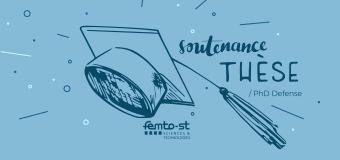You are here

Carol HABIB : Energy-efficient Data Collection and Fusion in Wireless Body Sensor Networks……
30 novembre à 10hPhD work : "Energy-efficient Data Collection and Fusion in Wireless Body Sensor Networks for Continuous Health Monitoring"
Abstract :
Several challenges exist in Wireless Body Sensor Networks such as the data collection and fusion especially that (1) wireless sensor nodes have limited energy, processing and memory resources, (2) the amount of periodically gathered data is huge, (3) the gathered data are characterized by a heterogeneous nature and (4) the data interpretation to ensure decision-support is influenced by several external factors such as the provided context information of the monitored person. In this thesis, firstly an energy-efficient data acquisition and collection technique is proposed. It targets the energy consumed by biosensor nodes for sensing and transmitting vital signs. It consists of a real-time sampling rate adaptation mechanism and a local detection system which are provided at the level of the nodes. Second, a multi-sensor data fusion model for health assessment is proposed. The coordinator of the network performs an assessment of the patient's health condition based on the collected measurements of his/her vital signs. Such data is interpreted in a human-reasoning way and are characterized by ambiguity and imprecision. Thus, we propose to use a Fuzzy Inference System. Then, a context-aware multi-sensor data fusion model for health assessment is proposed. Given that vital signs are highly correlated to the context of the monitored person such as his/her physical activity status, medical record and personal information, their interpretation is highly influenced. Hesitant fuzzy sets are used to subjectively evaluate the intensity of the person's physical activities based on his/her personal information and the activity's characteristics. Finally, a specific monitoring application is targeted. A real-time stress detection and evaluation framework is proposed while taking into consideration the energy consumption constraint. Shimmer 3 GSR+ is used as a wireless sensor node to sense the Photoplethysmogram (PPG) signal and the skin conductance. An android mobile application is developed to extract from the PPG signal stress correlated vital signs such as the heart rate, the respiration rate and the blood pressure.
The Jury members are:
Abderrahim BENSLIMANE, Professor at Université d’Avignon et des Pays du Vaucluse, Reporter
André-Luc BEYLOT, Professor at Université de Toulouse, Reviewer
Stéphane CHRETIEN, Senior Research Scientist à National Physical Laboratory, Reviewer
Raphaël COUTURIER, Professor at Université de Franche-Comté, PhD Director
Abdallah MAKHOUL, Assitant Professor HDR at Université de Franche-Comté, PhD co-Director
Rony DARAZI, Associate Professor at Université Antonine, PhD co-Director
Location : Amphithéâtre 3, Bâtiment A de l'IUT de Belfort-Montbéliard, 19 Avenue du Maréchal Juin, 90016 Belfort









